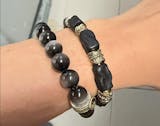What is the Difference Between Silver and Sterling Silver? A Complete Guide
Silver and sterling silver are often mistaken for each other, but they have distinct differences in terms of composition, durability, appearance, and usage. Understanding these differences can help you make informed choices when shopping for jewelry or other silver items. In this article, we’ll explore the difference between silver and sterling silver.
- 1. Composition: Pure Silver vs. Sterling Silver
- 2. Durability: Which Silver is Stronger?
- 3. Appearance: Luster and Tarnish
- 4. Cost Comparison: Silver vs. Sterling Silver
- 5. Uses: Where You’ll Find Silver and Sterling Silver
- 6. Maintenance and Care

1. Composition: Pure Silver vs. Sterling Silver
Pure Silver (Fine Silver): Also known as fine silver, pure silver is composed of 99.9% silver, with the remaining 0.1% consisting of trace elements. This level of purity gives it a bright, shiny finish and makes it less prone to tarnishing. However, pure silver is also soft and malleable, making it more likely to bend or lose its shape over time.
Sterling Silver: Sterling silver is an alloy that contains 92.5% pure silver and 7.5% other metals, usually copper. The addition of copper strengthens the silver, making it more durable and suitable for crafting intricate designs. This is why you’ll often see sterling silver stamped with the "925" mark, indicating its silver content.

2. Durability: Which Silver is Stronger?
Pure Silver: Due to its high purity, pure silver is relatively soft, making it less durable for everyday wear. It can easily get scratched or dented, which is why it's not commonly used in items that require strength and resilience, such as rings or bracelets.
Sterling Silver: Sterling silver is much more durable than pure silver. The alloyed copper makes it strong enough to withstand daily wear and tear, making it a popular choice for jewelry like necklaces, earrings, and rings. Its durability ensures that sterling silver pieces can last a lifetime with proper care.

3. Appearance: Luster and Tarnish
Pure Silver: Pure silver has a natural, soft luster that is more matte compared to sterling silver. It tends to maintain its color better over time because it doesn’t tarnish as quickly, thanks to its lack of reactive metals.
Sterling Silver: While sterling silver has a bright and shiny appearance, it is more prone to tarnishing due to the copper content. When exposed to air and moisture, sterling silver can develop a layer of tarnish that dulls its shine. However, regular cleaning and polishing can easily restore its original brilliance.

4. Cost Comparison: Silver vs. Sterling Silver
Pure Silver: Pure silver is generally more expensive than sterling silver because of its higher silver content. It is often used for investment pieces like coins and fine silverware, making it a less common choice for everyday jewelry due to its cost and softness.
Sterling Silver: Sterling silver is more affordable, making it the preferred option for those looking for beautiful, high-quality jewelry at a reasonable price. Its blend of affordability and durability offers great value, especially for those who want elegant pieces without the hefty price tag.
5. Uses: Where You’ll Find Silver and Sterling Silver
Pure Silver: Fine silver is often used in specialized items like collectible coins, bars, and high-end flatware. It’s also found in certain electrical components and industrial applications due to its high conductivity and low reactivity.
Sterling Silver: Sterling silver is widely used in the jewelry industry for crafting rings, necklaces, bracelets, and earrings. It is also popular in making silverware, decorative items, and even musical instruments due to its durability and aesthetic appeal.

6. Maintenance and Care
Pure Silver: Since pure silver doesn’t tarnish easily, it requires less maintenance compared to sterling silver. However, its softness means you need to handle it with care to prevent scratches or dents.
Sterling Silver: Sterling silver requires regular cleaning and polishing to keep its shine intact. Special silver-cleaning cloths or solutions can help remove tarnish and restore its original luster. Proper storage in airtight containers or anti-tarnish bags can also reduce tarnishing.
Related: How to Clean Silver Jewelry at Home: 5 Tips for Restoring Sterling Silver

Conclusion
The choice between silver and sterling silver ultimately depends on your needs and preferences. If you’re looking for high-purity silver with a soft finish for investment or specialized items, pure silver is a great choice. However, if you want durable, beautiful jewelry that can withstand daily wear, sterling silver is the ideal option. Its blend of strength, affordability, and classic style makes it a favorite for jewelry enthusiasts around the world.
Related Articles:
How Has Silver Jewelry Evolved From Classic to Modern Designs?
Top 10 Benefits of Wearing Stunning Sterling Silver Jewelry
Why Silver Jewelry Features Dragon Imagery: Unveiling Its Cultural Significance
Golden Jewelry vs. Silver Jewelry: A Comprehensive Comparison

























































